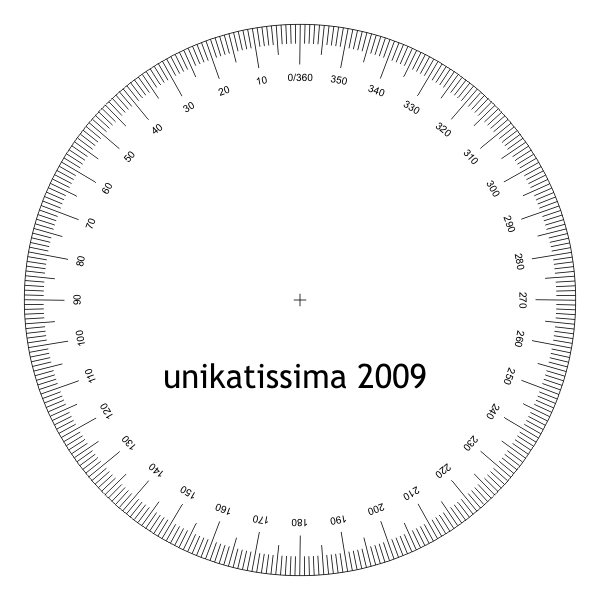Introduction
It is important to understand
what a radian and degree is, and how they relate to each other. This lesson
explains what that are.
Radians and
degrees are just different units for measuring an angle,
much like 'cm' and
'inches'. They are directly proportional to each other.
Degrees are a
unit of measurement that are used to express directionality and the
size of an angle. If you stand facing directly north, you are facing the
direction of zero degrees, written as 0°. If you turn yourself fully around, so
you end up facing north again, you have "turned through" 360°; that
is, one revolution (one circle) is 360°.
Below shows a
circle split into 360 sections. Each section is 1° (one degree):
 |
| circle split into 360 degrees |
You may ask yourself how it was decided that a circle should be split
into 360 parts - who created this magic number, and why, and why was it
called degrees?
Well we can all thank the ancient Babylonians who lived about 5000
years ago. They viewed the numbers 6, 12 and 60 as having particular
religious meanings and significance. It is because of them that we have
twelve-hour nights and twelve-hour days, with each hour divided into sixty
minutes and each minute divided into sixty seconds. And "once around"
is divided into 6×60 = 360 parts called "degrees".
So from now one, one thing to remember is when I mention 1 full
revolution, I am talking about 360°, and a half revolution would be, you
guessed it - 180° - also known as "about face".
90° represents a quarter of a circle.
Understanding initial and terminal angles meaning, and what an arc is
Run
the following following scenario in you mind:
1)
You are facing north holding your arm out in front of you
2)
you turn 90° to face west - sweeping your
arm across with you.
When
people talk about the "initial angle" this was your arms
starting position (north).
Where
your arm ended facing west - that is the "termainal angle"
The
action of your arm sweeping from the initial angle to the terminal angle is
known to have "swept out" a 90°
angle.
If
you imaging the line that your fingertips would have draw - the curve - is
known as the "arc", and the angle that was turned through is
said to "subtended" that arc.
Decimal Degrees and "Degrees, Minutes and Seconds"
When you work with degrees, you'll almost always be
working with decimal degrees; that is, with degrees expressed as decimal
numbers such as 43.1025°. But just as "1.75" hours can be expressed
as "1 hour and 45 minutes", so also "degrees" can be
expressed in terms of smaller units. These units, just as for
"hours", are called "minutes" and "seconds". Just
as "hours" can be expressed as decimals or else as hours - minutes -
seconds, so also "degrees" can be expressed as decimals or else as
degrees - minutes - seconds, denoted as "DMS".
- Convert 43.1025° to DMS form.
I can see that I have 43°, but what do I do with
the "0.1025" part? I treat it like a percentage of the sixty minutes
in one degree, and find out how many minutes this is:
(0.1025 degrees)(60 minutes / 1 degree) = 6.15
minutes
...or 6 minutes and 0.15 of a minute. Each minute
has sixty seconds, so:
(0.15 minutes)(60 seconds / 1 minute) = 9 seconds
Then 43.1025° = 43° 6' 9"
Notice the symbols: A single quote-mark (an
apostrophe) indicates "minutes" and a double quote-mark indicates
"seconds". This is similar to the notation (in Imperial measurements)
for "feet" and "inches": the smaller unit gets the
more-substantial mark.
- Convert 102° 45' 54" to decimal form.
Clearly, I've got 102°, but how do I convert the
minutes and seconds to decimal form? By using the definitions and doing the
divisions. The 45' means 45/60 of a degree, since each degree contains sixty
minutes. Simplification and long division gives me 45/60 = 3/4 = 0.75. So the
45' is 0.75°.
Now I need to deal with the 54". Since each
minute is sixty seconds, then I get 54/60 = 9/10 = 0.9. But this is minutes.
Now I need to convert the 0.9 of a minute to degrees:
(0.9 minutes)(1 degree / 60 minutes) = 0.015
degrees
So 102° 45' 54" = 102° + 0.75° + 0.015°
= 102.765°.
Radians
Why do we have to learn radians, when we already have perfectly good
degrees? Because degrees, technically speaking, are not actually numbers, and
we can only do math with numbers. This is somewhat similar to the difference
between decimals and percentages. Yes, "83%" has a clear meaning, but
to do mathematical computations, you first must convert to the equivalent
decimal form, 0.83. Something similar is going on here (which will make more
sense as you progress further into calculus, etc).
The 360° for one revolution ("once around") is messy enough.
Why is the value for one revolution in radians the irrational value 2π? Because this value
makes the math work out right. You know that the circumference C of a circle with
radius r is given by C = 2πr. If r = 1, then C = 2π. For reasons you'll learn later, mathematicians like to work with the
"unit" circle, being the circle with r = 1. For the math to make sense, the "numerical" value
corresponding to 360° needed to be defined as (that is, needed to be invented
having the property of) "2π is the numerical value of 'once around'."
Converting Between Radians and Degrees


















